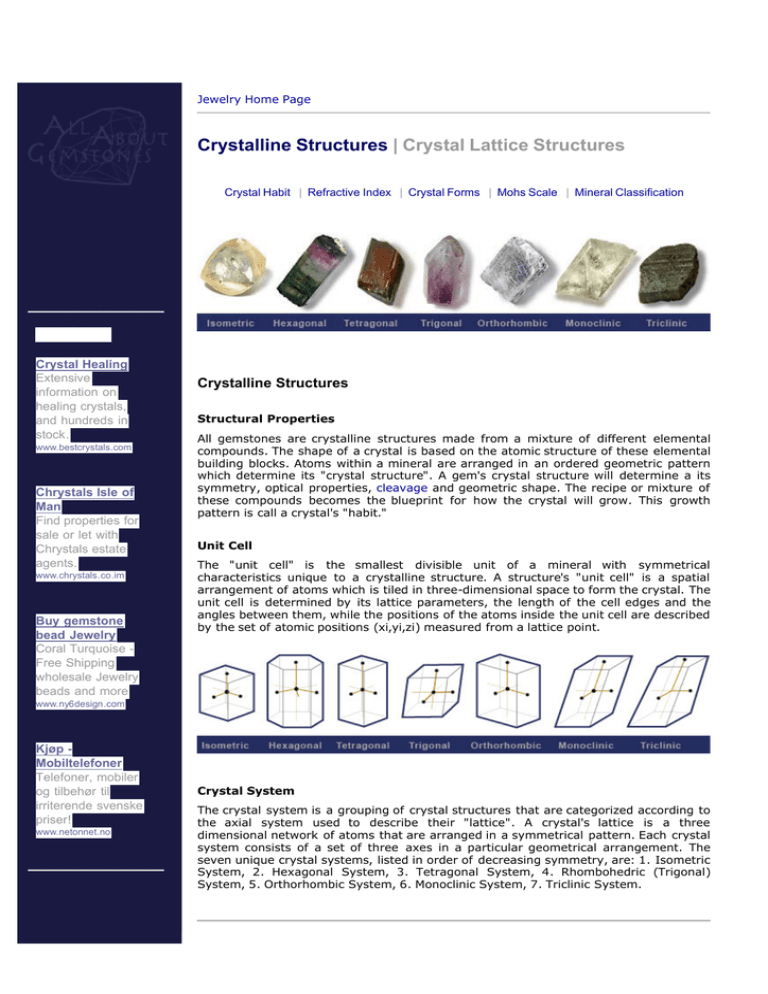
Jewelry Home Page
Crystalline Structures | Crystal Lattice Structures
Crystal Habit | Refractive Index | Crystal Forms | Mohs Scale | Mineral Classification
Crystal Healing
Extensive
information on
healing crystals,
and hundreds in
stock.
www.bestcrystals.com
Chrystals Isle of
Man
Find properties for
sale or let with
Chrystals estate
agents.
www.chrystals.co.im
Buy gemstone
bead Jewelry
Coral Turquoise Free Shipping
wholesale Jewelry
beads and more
Crystalline Structures
Structural Properties
All gemstones are crystalline structures made from a mixture of different elemental
compounds. The shape of a crystal is based on the atomic structure of these elemental
building blocks. Atoms within a mineral are arranged in an ordered geometric pattern
which determine its "crystal structure". A gem's crystal structure will determine a its
symmetry, optical properties, cleavage and geometric shape. The recipe or mixture of
these compounds becomes the blueprint for how the crystal will grow. This growth
pattern is call a crystal's "habit."
Unit Cell
The "unit cell" is the smallest divisible unit of a mineral with symmetrical
characteristics unique to a crystalline structure. A structure's "unit cell" is a spatial
arrangement of atoms which is tiled in three-dimensional space to form the crystal. The
unit cell is determined by its lattice parameters, the length of the cell edges and the
angles between them, while the positions of the atoms inside the unit cell are described
by the set of atomic positions (xi,yi,zi) measured from a lattice point.
www.ny6design.com
Kjøp Mobiltelefoner
Telefoner, mobiler
og tilbehør til
irriterende svenske
priser!
www.netonnet.no
Crystal System
The crystal system is a grouping of crystal structures that are categorized according to
the axial system used to describe their "lattice". A crystal's lattice is a three
dimensional network of atoms that are arranged in a symmetrical pattern. Each crystal
system consists of a set of three axes in a particular geometrical arrangement. The
seven unique crystal systems, listed in order of decreasing symmetry, are: 1. Isometric
System, 2. Hexagonal System, 3. Tetragonal System, 4. Rhombohedric (Trigonal)
System, 5. Orthorhombic System, 6. Monoclinic System, 7. Triclinic System.
The Seven Crystal Systems
1. Cubic
The Cubic crystal system is also known as the "isometric" system. The Cubic
(Isometric) crystal system is characterized by its total symmetry. The Cubic system has
three crystallographic axes that are all perpendicular to each other and equal in length.
The cubic system has one lattice point on each of the cube's four corners.
2. Hexagonal
The Hexagonal crystal system is has four crystallographic axes consisting of three
equal horizontal or equatorial (a, b, and d) axes at 120º, and one vertical (c) axis that is
perpendicular to the other three. The (c) axis can be shorter or longer than the
horizontal axes.
3. Tetragonal
A Tetragonal crystal is a simple cubic that is stretched along its (c) axis to form a
rectangular prism. The Tetragonal crystal will have a square base and top, but a height
that is taller. By continuing to stretch the "body-centered" cubic one more Bravais
lattice of the Tetragonal system is constructed.
4. Rhombohedral
A Rhombohedron (aka Trigonal) has a three-dimensional shape that is similar to a cube
that has been compressed to one side. Its form is considered prismatic, as all faces are
parallel to each other. The faces that are not square are called "rhombi." A
rhombohedral crystal has six faces or rhombi, 12 edges, and 8 vertices. If all of the
non-obtuse internal angles of the faces are equal (flat sample, below), it can be called a
trigonal trapezohedron.
5. Orthorhombic
Minerals that form in the Orthorhombic (aka Rhombic) crystal system have three
mutually perpendicular axes, all with different or unequal lengths.
6. Monoclinic
Crystals that form in the Monoclinic System have three unequal axes. The (a) and (c)
crystallographic axes are inclined toward each other at an oblique angle, and the (b)
axis is perpendicular to a and c. The (b) crystallographic axis is called the "ortho" axis.
7. Triclinic
Crystals that form in the Triclinic System have three unequal crystallographic axes, all
of which intersect at oblique angles. Triclinic crystals have a 1-fold symmetry axis with
virtually no symmetry and no mirrored planes.
Crystal Forms
Closed & Open Forms
Any grouping of crystal faces or facets that are arranged in the same symmetry is
called a "form." There are approximately 48 crystal forms broken down into "open" or
"closed" categories. There are 30 "closed" and 18 "open" crystal forms. "Closed Forms"
are those groupings of facets that are related by symmetry and completely enclose a
volume of space.
Vectorial Properties of Crystals
Although a crystal structure is an orderly arrangement of atoms on a lattice, the order
may be different along different directions or axis in the crystal. Certain properties of a
particular crystal can depend on direction. These variable properties are called
"vectorial properties", which are divided into two categories: continuous and
discontinuous. An example of a "continuous property" is a crystal's hardness. An
example of a "discontinuous property" would be cleavage.
Page 2: Crystal Forms
Page 3: Crystal Habit
Return to General Information
Referance Credits & Suggestions for Further Study on Crystal Geometry
1. University of Wisconsin, The 48 Special Crystal Forms
2. Web Mineral,
webmineral.com
Minerology
Database -
Crystallography
3. Tulane University, External Symmetry of Crystals
and
Minerals by
Crystal Form
. www.tulane.edu
4. Rockhounds, Introduction to Crystallography
5. MathWorld, Solid Geometry
6. W. S. MacKenzie, A. E. Adams, Color Atlas of Rocks and Minerals
7. Judith Crowe, The Jeweler's Directory of Gemstones
. John Wiley & Sons
. DK Publishing
.
8. Walter Schumann, Gemstones of the World
9. Renee Newman, Gemstone Buying Guide
. NAG Press; 2Rev Ed edition
. International Jewelry Publications; 2nd edition
10. Paul R. Shaffer, Herbert S. Zim, Raymond Perlman, Rocks, Gems and Minerals
Ads by
Google
Blue Crystal
Jewelry & Gemstones
Copyright © 2007 KHI, Inc. All rights reserved.
Crystal Choker
Crystal Point
. Martin's Press
Crystal Shop

